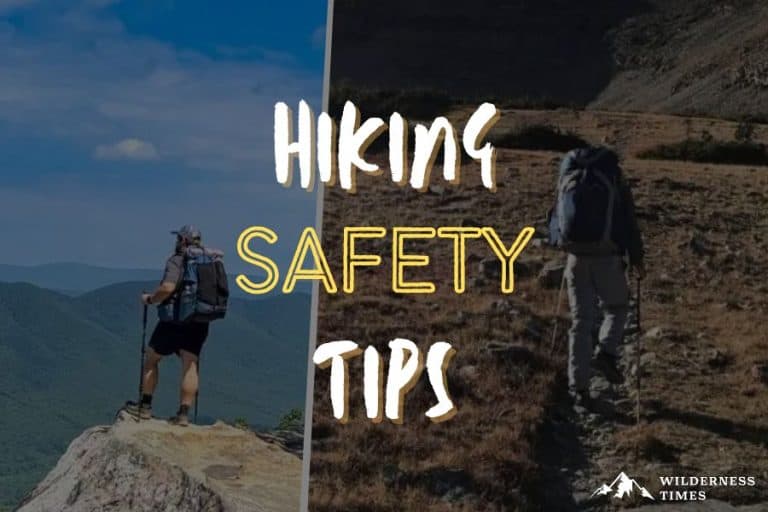Hiking safety tips!
They’re essential to know! Trust me; I’ve learned a lot of them during my decade-plus of hiking.
Sometimes I’ve had to learn safety techniques the hard way. You know, by experiencing them first.
But by reading this article, you can avoid experiencing some of the things I have in the last 10+ years. So I thought I’d put together an ultimate guide on your safety while enjoying the outdoors.
Hiking doesn’t have to be unsafe. And it doesn’t take a safety expert to be a safe hiker, either.
Most of it is common sense. But some of them are unique hacks to help you make the best out of your hiking experience.
Let’s get into the hiking safety tips you should live by while on the trail.
Safety Precautions: Preparing for a Hike
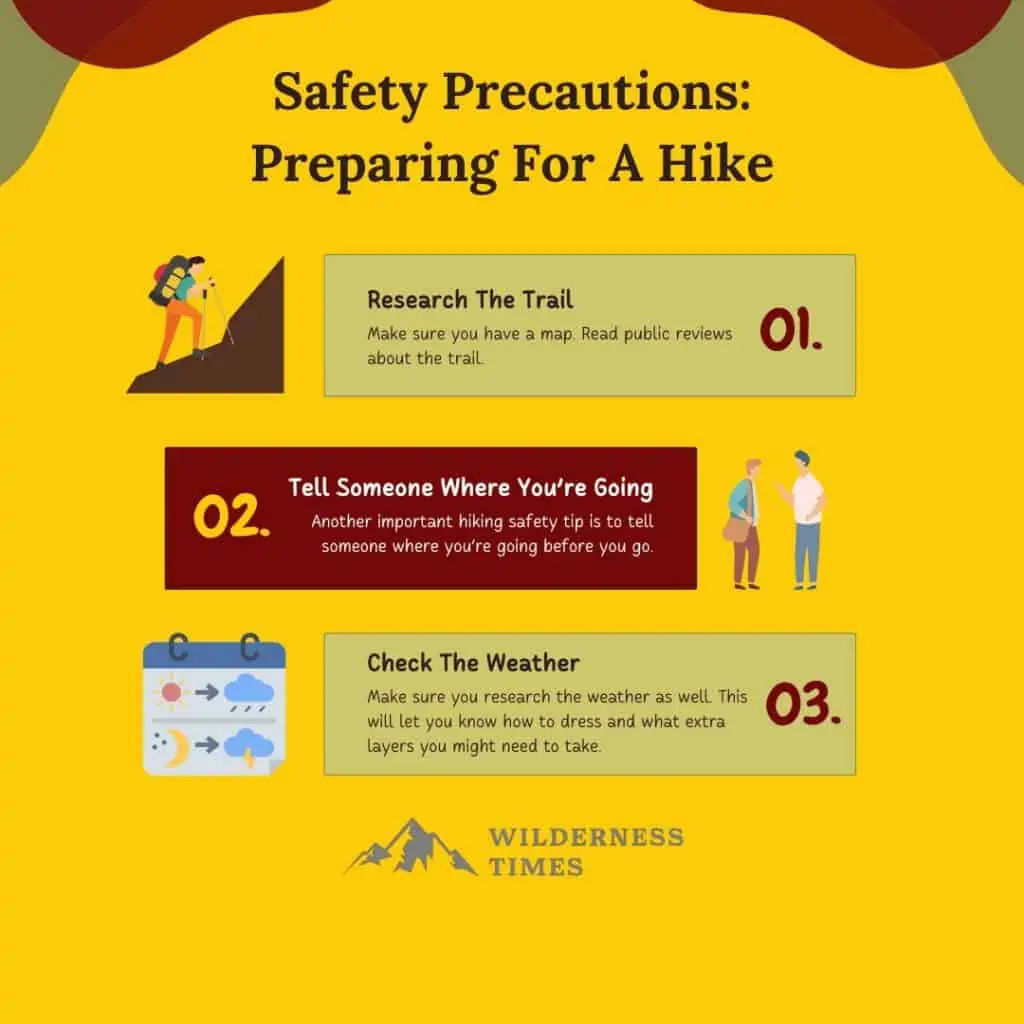
Hiking is like taking a mini-vacation.
You want to have a plan to ensure your trip is successful and as satisfying as you hope.
Planning before you go will help keep you safe and have a good time.
Research The Trail
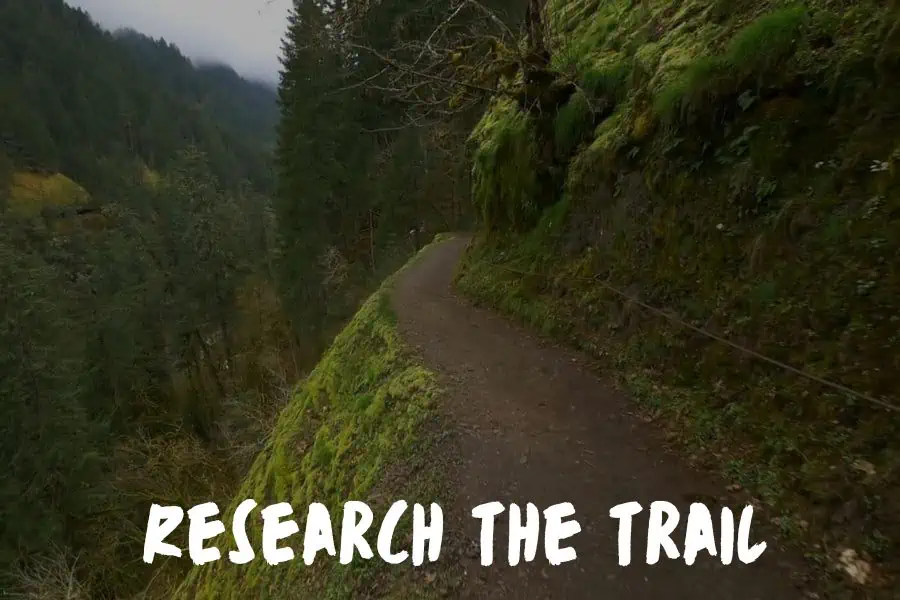
The first thing you should do is research the trail you plan to hike.
Make sure you have a map. Read public reviews about the trail using an app like AllTrails.
Look for any official trail alerts. Understand how far the trail is and the level of difficulty. Try to know as much as possible about the trail before you go.
Let someone know where and when you are going
Another important hiking safety tip is to tell someone where you’re going before you go.
Give that person a map and show them the area you will be in. If for some reason, you don’t make it back home, that information will be vital for search and rescue.
Could you imagine being alone and hurt in the middle of the forest, and no one knows where you are?
Prevent that altogether by saying something about where you plan to go and when you plan to be back.
Check The Weather Ahead of Time
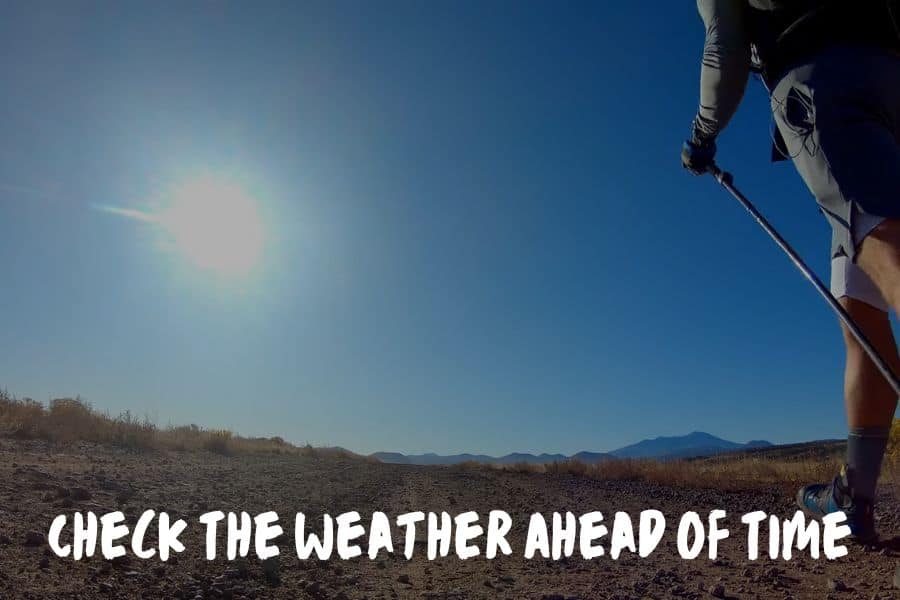
Make sure you research the weather as well. This will let you know how to dress and what extra layers you might need to take.
The weather forecast might also help you decide to reschedule if the conditions are not looking favorable.
Planning your hike will help keep you safe and ensure you have the best experience possible because you’ll know what to expect.
The Ten Essentials (gear)
Have you ever seen the meme below?
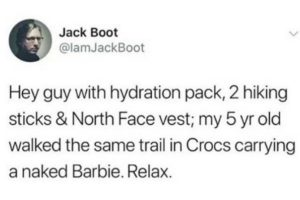
That meme has always bothered me. It’s easy for an inexperienced hiker to say that and turn it into a joke until lack of gear hinders their hiking experience.
Your half-naked barbie doll isn’t going to keep you hydrated if you get lost on rolling hills in the backcountry.
Gear is meant to keep you healthy and alive while you are hiking the unforgiving outdoors.
There is such thing as taking too much gear, but there is also a problem with not taking enough.
Luckily, there are proven essential gear items that most seasoned hikers recommend you take. Let’s take a look at those items now.
Appropriate Apparel and Footwear
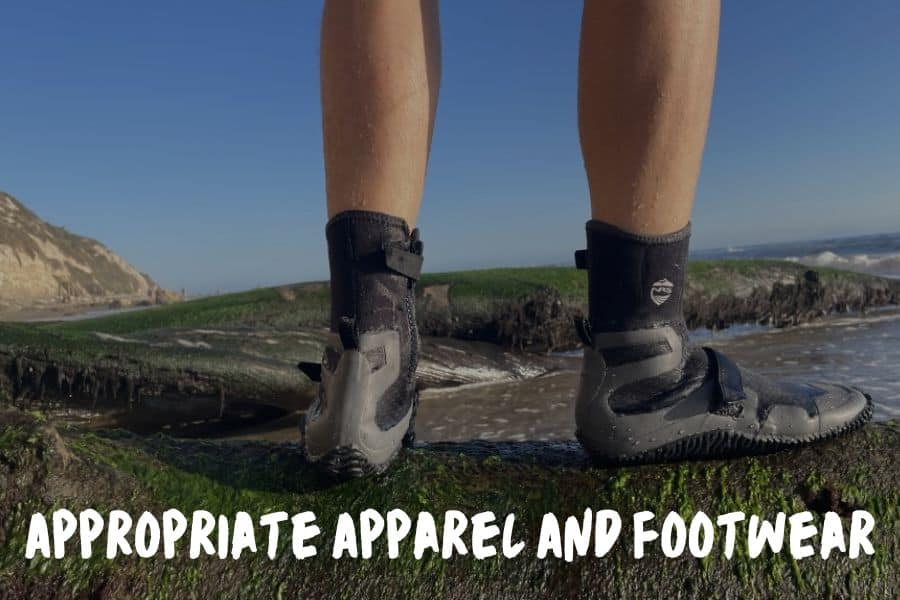
Wear comfortable hiking apparel that breaths well and feels good. Outdoor-specific footwear is a must.
Hiking boots will help protect your feet and ankles from injuries. Hiking-specific socks can help protect your feet as well.
Navigational Gear
Bring a paper map and a compass but make sure you understand the fundamentals of map and compass reading. Bring a GPS device or download an app for your phone.
Hydration and Purification
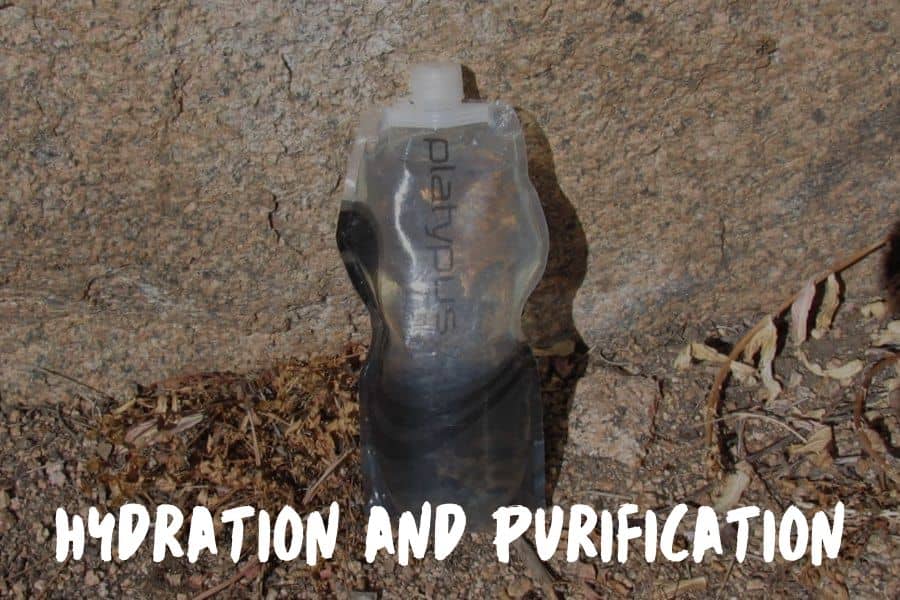
Your water should be the heaviest item in your backpack. Don’t hold out on the water because it weighs more.
You should bring a water filter and know how to use it (test it before use), but you should also get plenty of water if there is nothing to filter.
Read: How To Purify Water In The Wild
Food and Snacks

Bring some snacks with you on your hike.
As you hike, you burn calories and natural fuel.
Good snacks such as trail mix or snack bars will help you replenish the energy you need to keep going.
You might also bring a meal and maybe some hiking cookware to heat it if you plan to be out for a while.
Rain Gear and Extra Layers
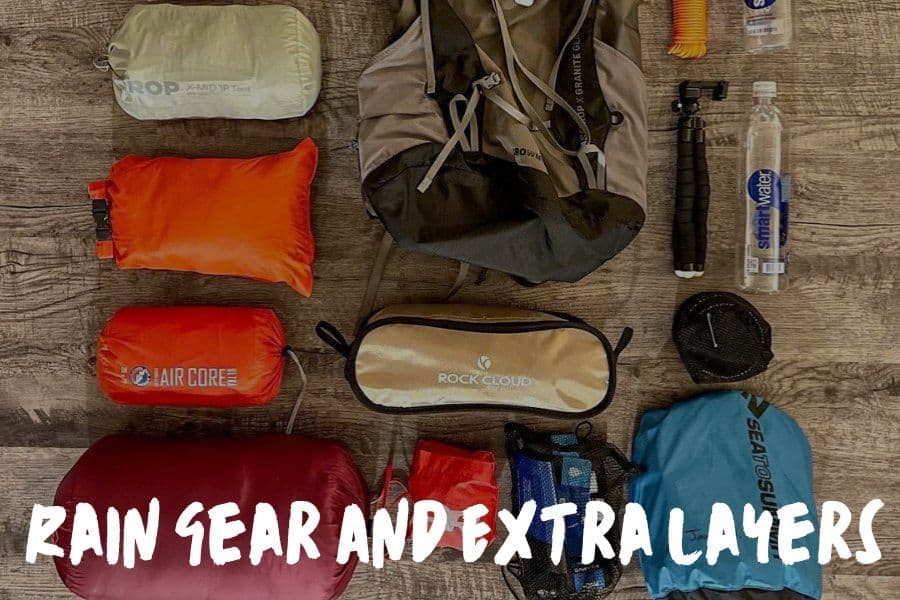
Bring rain gear if there is a chance of rain. Additional layers are also a good idea.
Compression-based running shirts and tights are great different layers that hardly weigh anything.
Read: 7 Useful Tips For Hiking In The Rain
Survival Gear
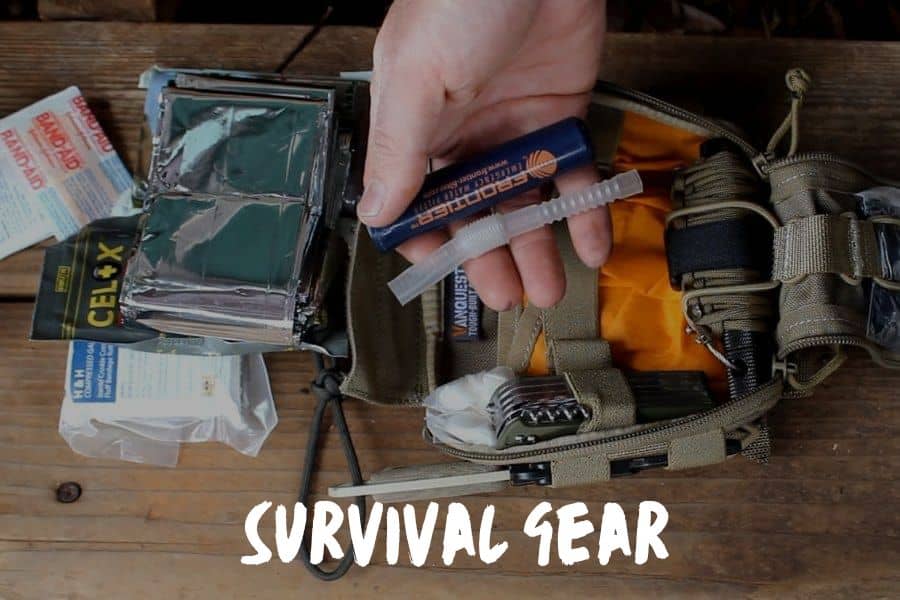
If you bring an oversized rain poncho for the gear item suggested above, it can make an excellent emergency shelter if you need it to be.
Bring a knife and any tools you might need, such as a folding saw to cut firewood. Bring light and waterproof matches.
Bring a whistle in case you need to alert others for help.
Lights and Extra Batteries
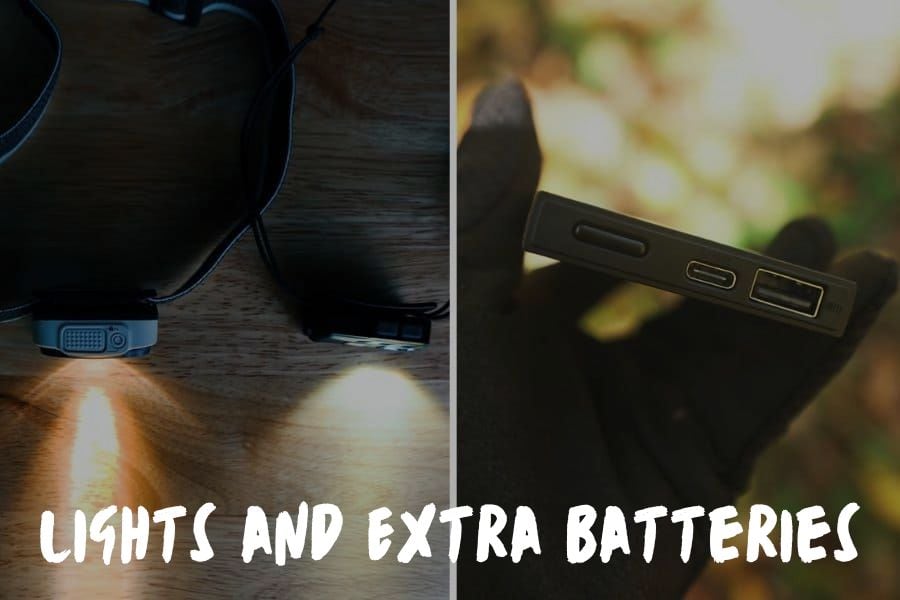
Bring at least two forms of light, such as a flashlight and a headlamp. Bring extra batteries.
Turn your batteries around the wrong way in the flashlight and headlamp.
This allows you to prevent the device from accidentally turning on and draining the battery life.
First Aid Kit
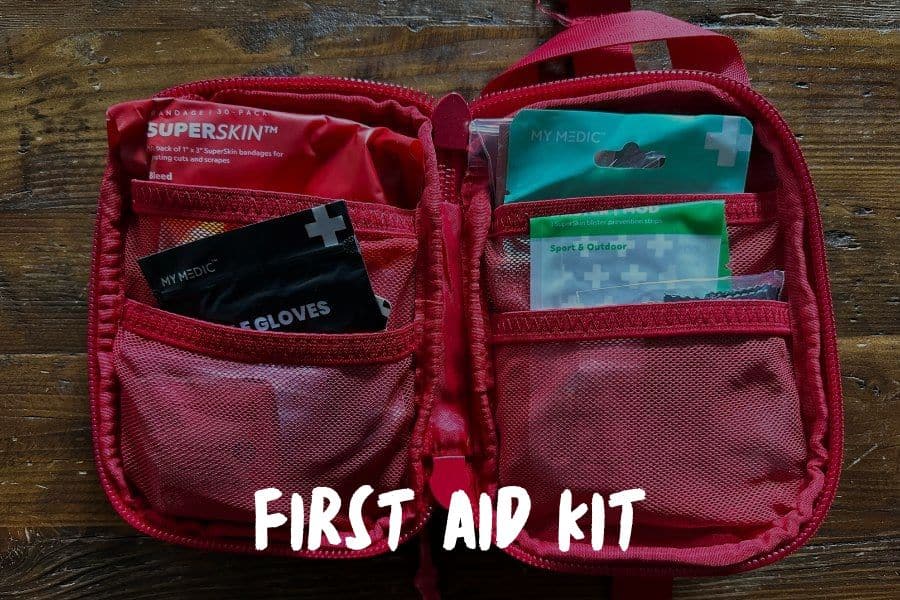
Bring a first aid kit with standard supplies you would likely need on the trail.
Make sure you know how to use everything in your equipment. It takes up space and adds extra weight if you don’t know how to use it.
Hiking safety means having an excellent first aid kit.
Skin Protection
Bring essential skin protection for the elements. Sunblock spray or lotion is recommended to protect you from harmful UV rays.
Chapstick is a good item to bring to protect your lips from the wind. Bug spray is an excellent idea to protect you from biting insects.
It is always recommended to spray your apparel and gear with permethrin at least 24 hours before your hike to mitigate ticks.
An Outdoor Restroom Kit
Bring some toilet paper, a Ziplock bag, and a small hand shovel. You might have to dig out a restroom.
Remember to bury your waste, but not the toilet paper. Put it in an airtight bag and take it out with you.
Buried toilet paper can harm critters and the environment in general. Leave it better than you found it.
You don’t want to forget this kit, or you have to learn the hard way as I did. It took a while for that rash to go away!!!
Staying Safe on the Trail
It’s essential to practice the safety of the trail and make it a habit.
Hiking safety starts by watching where you are hiking. You should be looking up, down, and from side to side at all times.
You should always watch where you will be stepping next. Doing these simple things will prevent you from most hazards associated with hiking.
Another safety trick is to stay on the trail at all times. Once you get off the trail, your chance of encountering a hazard is significantly increased.
There could be holes, open wells, edges of cliffs, and even venomous snakes off the trail that you might encounter. Staying on the trail will also help prevent you from getting lost.
While staying on the trail and watching where you are stepping, remember to look around. Look around at different trees, rocks, and landmarks.
Try to remember some of these. If you get turned around or lost, remembering these things can help you find your way again.
Always put hiking safety on the trail before anything else.
Hiking Safety when Hiking Alone
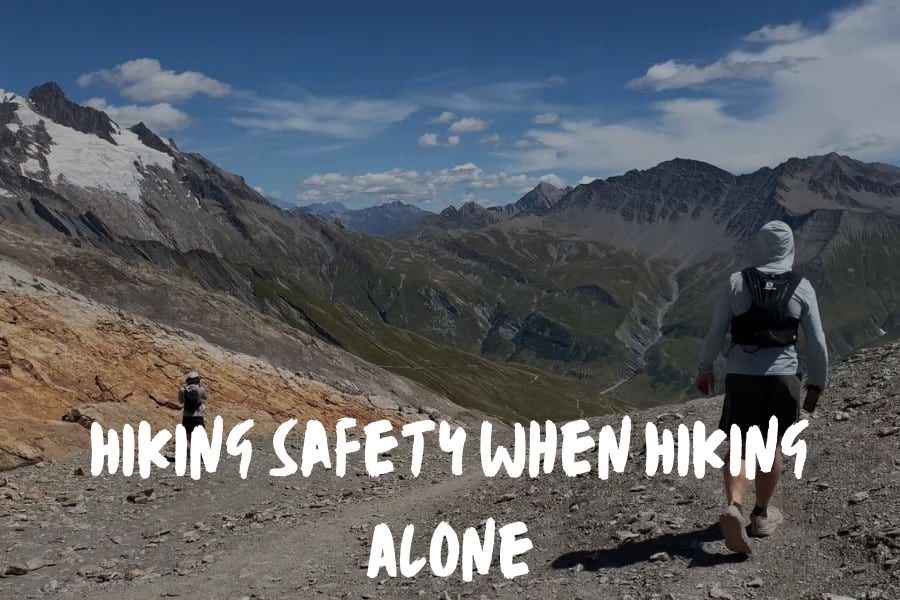
It’s best to hike with a buddy. I hike with my girlfriend almost every time we hike.
But, understandably, sometimes you want to hike alone. We all do. Hiking alone can be very uplifting and help you gather your thoughts.
But hiking alone also increases hazards to your safety. You can do some things thought to help prevent those hazards from occurring.
No Risky Situations
The first thing you should do is not put yourself in risky situations. Ask yourself before doing something if you need someone there in case something goes wrong.
And then try to think of an alternative but a safer way of doing it instead.
You wouldn’t want to try to cross a raging creek without someone with you to grab you if you start getting washed away, right?
Mind Your Ability
Another thing to remember is your ability to hike. Don’t hike more than you think you can when hiking alone.
Shorter trails and loops are the types of hikes when going solo.
Take Plenty of Breaks
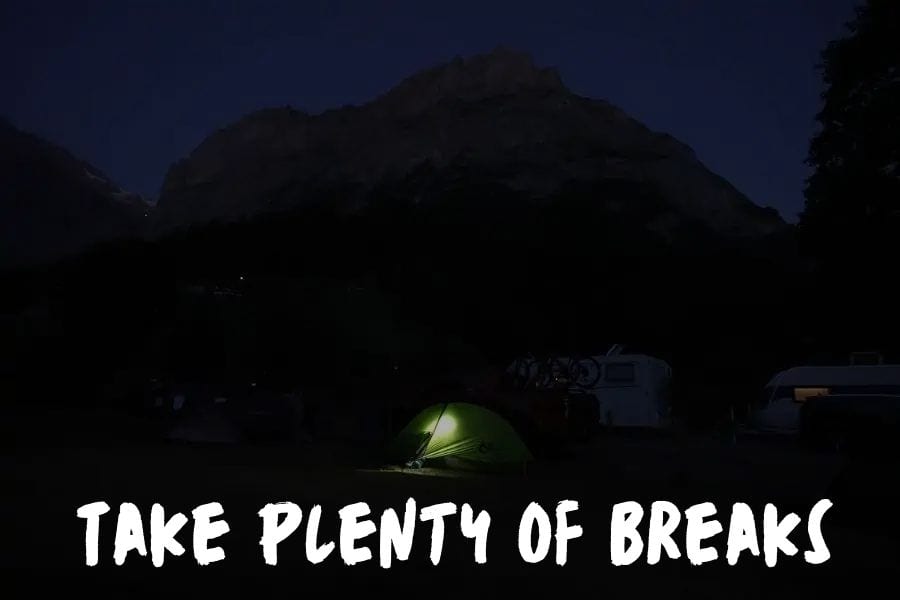
Remember to take plenty of breaks when hiking solo.
It is too easy to get hiking alone and go too far without stopping and taking a little rest break.
You might even set your watch to beep, reminding you to stop, drink water, and rest for a bit.
Stop and smell the roses! It took me a while to figure that out, but hiking got so much easier for me once I did.
Also See: Solo Backpacking: Everything You Need To Know to Camp or Backpack Alone
Summer Hiking Safety Tips
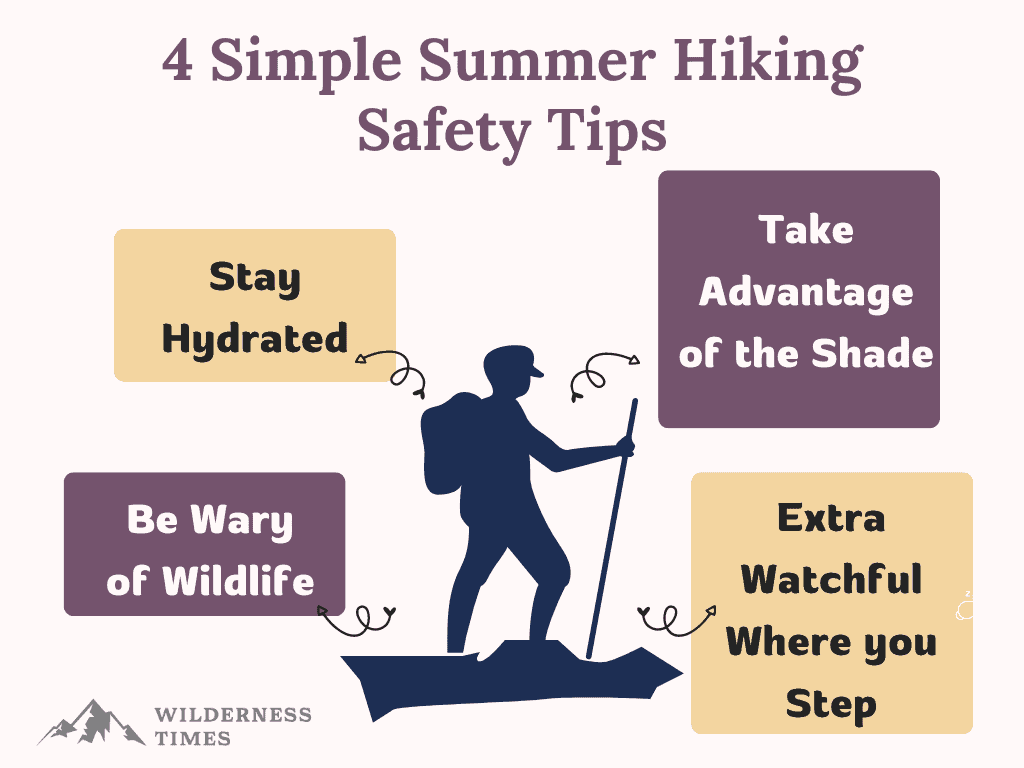
Summertime can be a particular time to hike, especially if you’re going to a swimming hole.
But with summer also usually comes humidity, biting insects, and spider webs across the trail.
You can take plenty of measures to enjoy summer hikes while dealing with these extra hassles.
Stay Hydrated
One of the main things you need to do is stay hydrated. Dehydration is a very common injury that occurs while on the trail.
In most cases, it is a severe injury. Sometimes it results in death. You can completely prevent dehydration by staying hydrated.
Take a few drinks a few hours and ensure you bring enough water to drink. Mix electrolytes with your water as you will lose a lot of salt in your sweat.
I had to learn this the hard way. After 10 miles of hiking on the hottest day of the year, I didn’t hydrate properly.
Once I returned to my vehicle, I almost had to call 911. I was dizzy, drained, and started cramping up. I barely got myself home.
I was alone and dehydrated. Don’t experience that – I know I never will again!
Take Advantage of the Shade
If you are hiking and you walk up to a stump or a large rock that would make a great seat, sit down and take a few minutes to rest.
Did you know the shade is usually a cooler spot during the hottest days? Like I said, take advantage of that.
Be Wary of Wildlife and Bugs During the Summer
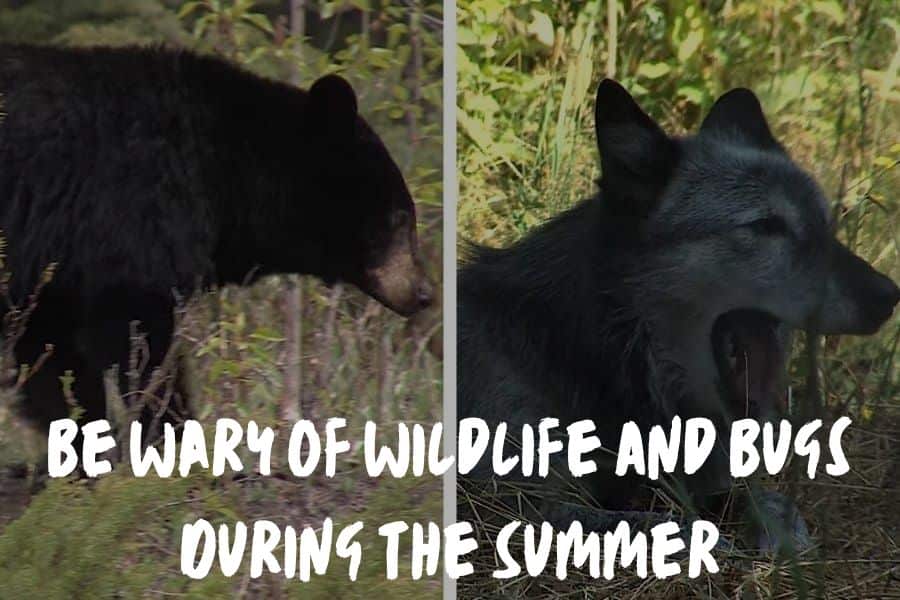
Many potentially dangerous wildlife such as bears, mountain lions, and venomous snakes move more in the warmer months.
Insects such as mosquitoes, biting flies, and ticks are also often out. Make sure you bring repellent with you to ward them off if needed.
Read: Does Bear Spray Work on Mountain Lions?
Be Extra Watchful Where you Step
During the summer since everything is usually so grown up and harder to see.
Winter Hiking Safety Tips
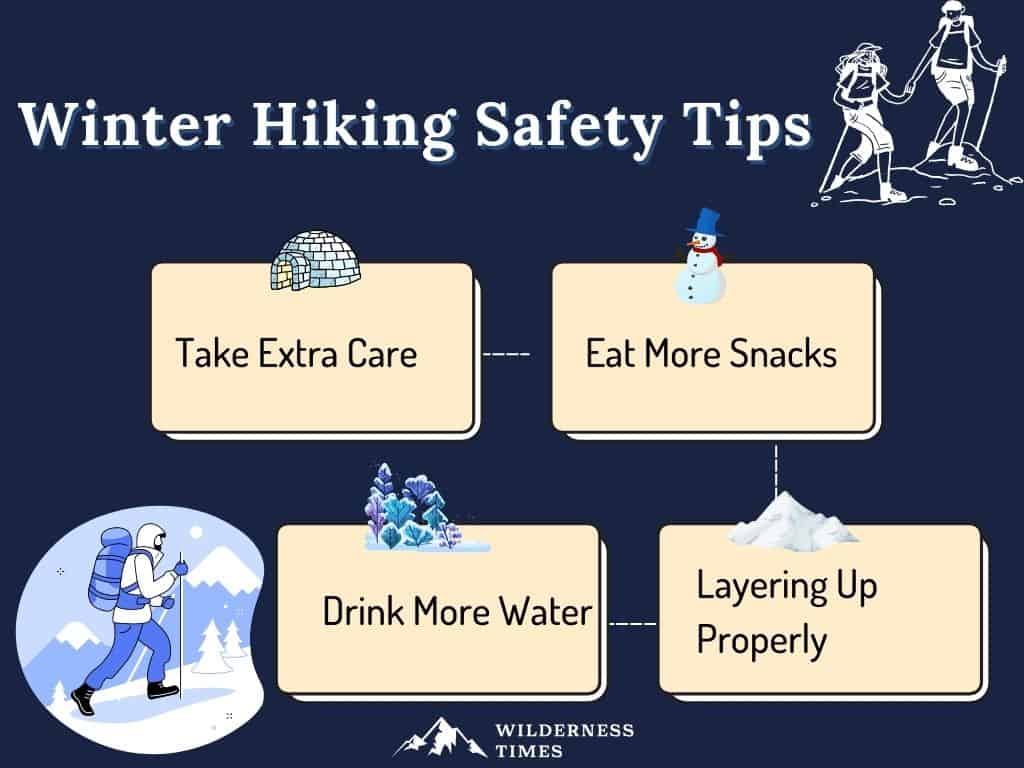
Don’t let cold weather scare you away from the trail! Winter is a great time to hike for many different reasons.
There are mosquitoes or ticks. You can see everything. And most potentially dangerous animals are hibernating.
But with winter also comes extra hazards. Snow and ice can make conditions very slick.
The cold temperatures can cause cold-related injuries. Just like summer, you must also take special precautions in the winter.
Take Extra Care
Be extra careful around the edges of cliffs and bluffs. It doesn’t take much to slip and fall. The leading cause of hiking fatalities in the United States is from falls.
You might want to invest in a good pair of snow cleats that fit over your boots and give you traction in the snow and ice.
You should also slow down while hiking and watch each step you take.
Eat More Snacks & Drink More Water
It might not be summer anymore, but snow and icy conditions take a lot of energy to hike through. You’re going to be losing natural fuel quickly. Make sure you put it back in you.
Layer
The idea of keeping yourself warm during the winter is to do it by layering up properly. You want to wear a base layer such as cold-weather compression gear designed to wicker sweat.
After that, your next layer should be your hiking pants and shirt. Wear a comfortable pair of winter socks. Wear gloves.
Wear a good outer layer consisting of a windproof and water-resistant shell or jacket. When choosing what to wear, try to layer up so that you can remove items of clothing if you get too warm.
What if you fall in a creek? It can happen. It’s happened to me. This is why I suggest getting a pair of insulated run tights and long sleeve shirt – like what runners wear.
They’re lightweight, and runners wear them alone on the coldest days. Put them in a sealed Ziplock bag, and if your clothes get soaking wet, you have an emergency change of clothes.
Getting all your clothing wet in the cold backcountry can be life-threatening. Winter hiking can be a lot of fun, but it demands that you pay extra attention to safety.
Night Hiking Safety Tips
Night hiking can be pretty satisfying. Bring a handheld blacklight and let the magic begin as you shine it on things that glow in the dark.
But with darkness also comes a more significant hazard. This is because you can’t see the possible risks in front of you.
You need to pay extra attention when hiking at night.
You Want to Stay on the Trail at all Times
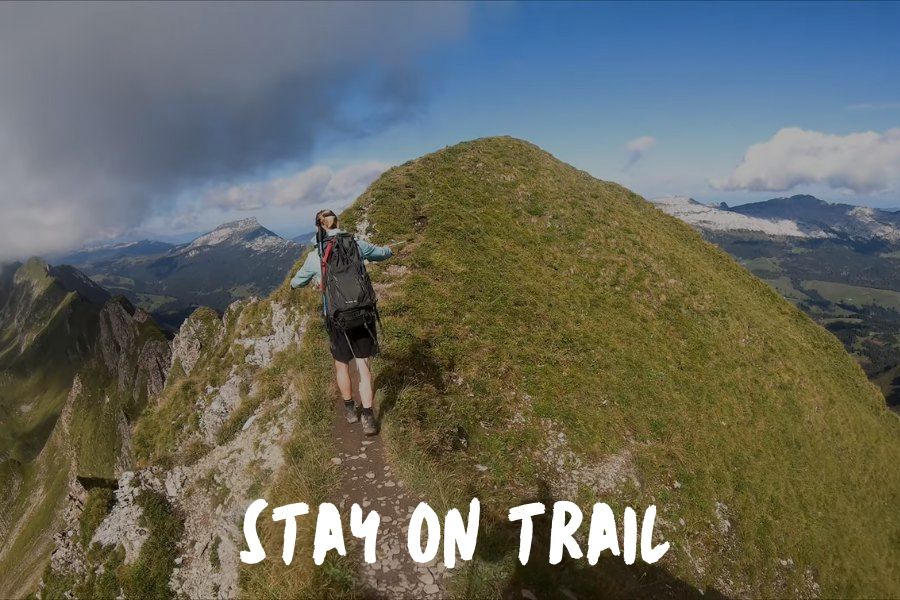
The trail is going to look different at night. The whole forest is going to look alien. It doesn’t matter how well you think you know the trail; at night, it becomes a different trail.
Stay on the trail, and don’t venture off too far. Night hikes are best on easier and shorter trails.
Make Sure you Bring an Excellent Light Source With You
You should carry some extra batteries, too. Losing the ability to see in the dark can devastate your safety. There are a lot of hazards already in the woods. Not having light to see them will only make them worse to encounter firsthand.
Move Slowly
You usually don’t see hazards at night until you’re with them. You should move slowly, watch your step, and use your light.
You don’t want to spook potentially dangerous wildlife or accidentally step on a venomous snake. The darkness could also hide holes, unprotected wells, and cliffs.
Night hiking is unique and recommended as long as you put safety first.
Hiking Safety FAQ
What are some common hiking mistakes to avoid?
Make sure that your hike matches your physical and mental abilities. Don’t choose a hike that is more than you can handle.
We all start small and work our way up to more strenuous hikes. Start with the more accessible trails and advance to tougher ones as you get better at them.
Remember that nature is rugged and unforgiving. If you break down on the highway in your car, you can get help fairly easily and quickly.
Getting lost in the woods could take all night or longer before search and rescue workers find you.
Nature doesn’t have engineering controls present to prevent you from being injured. Remember this before venturing out into it.
What should you not do on a hike?
Try to avoid hiking alone if you can. It is better to have a friend just in case something goes wrong.
You can find all sorts of people in your area to go hiking with on social media. Just be safe about meeting them.
It is good to find others that get into what you get into. Another hiking buddy will help motivate you, and both of you will get better at hiking at the end of the day.
Don’t leave your trash or litter on the trail. Human garbage (including something as insignificant as an apple core) takes years to even decades to degrade.
Trash left behind can harm wildlife if they consume the waste. Littering is harmful to nature and can destroy important ecosystems and habitats.
Pack out what you pack in and leave the area better than you found it.
What are some things to remember before a hike?
Make sure you pack everything you will be using on your hike. Do a quick inventory of what you will be taking with you.
Take out what you don’t need to help conserve space and weight. The most important thing to take with you is hydration and fuel (drinks and food).
Make sure you check the weather before your hike. Don’t risk hiking if there is a chance for severe weather.
It doesn’t take a whole lot of wind to make trees fall. It doesn’t take much rain to cause a flash flood in some areas.
Lightning can cause wildfires. Severe weather isn’t anything to take for granted.
What are some dangers of hiking?
Open up a new tab on your favorite search engine. Type in “hiker dies” and press enter. The number one reason for hiking fatalities is slips and falls.
That also happens to be a number one injury in the workplace. Falling at work might lead to an injury, but falling in nature could mean the end of your life.
If that many people are dying from falls – isn’t that enough for you to pay attention and put safety first?
Dehydration is another common cause of severe injury and even death in the hiking community. Without hydration, your body will experience significant problems.
You should always pack enough water and snacks to help keep you hydrated and fueled during your hike. Even if water weighs your pack, it is worth staying in good health versus having a medical emergency.
Is hiking considered a high-risk activity?
Hiking isn’t a dangerous activity. The danger comes into play through the choices we make. The threat will significantly increase if you do risky things while hiking.
You ultimately control most of the hazards and risks you will face while hiking. It is your choice how it all plays out.
Always Remember, Safety First!
Hiking safety should be a priority before, during, and after your trip. Following the advice above will help keep you safe while enjoying nature.
Put safety first so that you can enjoy nature for years to come. What other hiking safety advice would you recommend to others on the trail?


